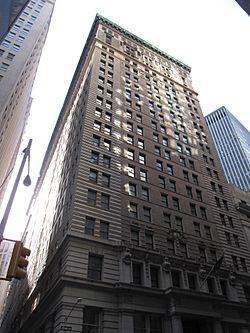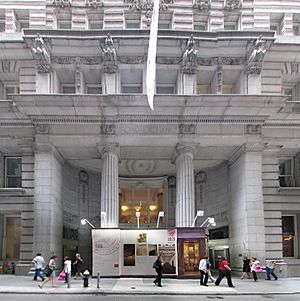Broad Exchange Building facts for kids
|
Broad Exchange Building
|
|
|
U.S. Historic district
Contributing property |
|

Broad Street facade
|
|
| Location | 25 Broad Street, New York City |
|---|---|
| Built | 1900–1902 |
| Architect | Clinton & Russell |
| Architectural style | Renaissance |
| Part of | Wall Street Historic District (ID07000063) |
| NRHP reference No. | 98000366 |
Quick facts for kids Significant dates |
|
| Added to NRHP | April 13, 1998 |
The Broad Exchange Building, also known as 25 Broad Street, is a tall building in the Financial District of Lower Manhattan in New York City. It stands at the corner of Exchange Place and Broad Street. The building has 20 or 21 stories and was designed by the architects Clinton & Russell. It was built between 1900 and 1902.
The Alliance Realty Company built the Broad Exchange Building to rent out offices. When it was finished, it was the largest office building in Manhattan. Today, it has 307 apartments. The building's design looks like a classic column, with a base, a middle section (shaft), and a top (capital). The Broad Exchange Building is close to the New York Stock Exchange Building. Because of this, many financial companies wanted offices there.
The building has been sold many times over the years. In the late 1990s, it was changed from offices into apartments. A part of the building on the south side was taken down in the early 2000s. The Broad Exchange Building was added to the National Register of Historic Places in 1998. It was also named a city landmark in 2000. It is part of the Wall Street Historic District.
Contents
About the Broad Exchange Building
Where is it Located?
The Broad Exchange Building is in the Financial District of Manhattan. It is at the southeast corner of Broad Street and Exchange Place. The block where the building stands is bordered by Broad Street to the west, Exchange Place to the north, William Street to the east, and Beaver Street to the south. The building has a long side facing Broad Street and an even longer side facing Exchange Place.
Originally, the building was shaped like an irregular "T". It had a wing that went south towards Beaver Street. This southern wing was later removed in the early 2010s. The building is near other important places. These include the New York Stock Exchange Building and Federal Hall. There are also subway entrances for the Broad Street station right next to the main entrance.
What Does it Look Like?
The Broad Exchange Building was designed in the Italian Renaissance Revival style. It is about 276 feet (84 meters) tall. The building has either 20 or 21 stories.
The main side of the building on Broad Street has 10 vertical sections, called bays. The side on Exchange Place has 26 bays. The building's design is split into three main parts, like a classical column.
- The bottom three stories are covered with rough-looking granite blocks.
- The middle 14 stories are made of brick with some terracotta decorations.
- The top three stories are made of granite and terracotta. A copper cornice (a decorative ledge) sits at the very top.
At the street level on Broad Street, there is a main entrance that sticks out a little. It has Doric columns and the words "BROAD EXCHANGE" above the doors. There is also a similar, but flatter, entrance on Exchange Place.
The 4th through 17th stories are mostly brick. The outer parts of these stories on Broad Street and Exchange Place have rough terracotta. The 18th through 20th stories are the top part, or "attic" section. They also have rough terracotta on the outer bays. A copper cornice runs above the 20th story. There is also a penthouse on the roof, which some people count as a 21st story.
Inside the Building
The Broad Exchange Building uses strong foundations called caissons. These go down about 40 feet (12 meters) to the solid rock below. The building's frame is made of steel. This allowed it to be built much taller than older buildings. It has a basement and a sub-basement with machinery and large storage areas.
When it was first built, the Broad Exchange Building was like "a town under one roof." It had many elevators and a huge amount of space for offices. Each floor had about 40 offices, but they were designed to be open and flexible. The first few floors had very high ceilings, which was good for banks.
After it was changed into homes, the building now has 307 condominium apartments. These include one-bedroom and two-bedroom units, plus four large penthouse apartments on the top floor. The apartments have high ceilings, wooden floors, and modern appliances. The penthouses even have outdoor terraces.
The building also has many shared spaces for residents. There's a lounge, a game room, indoor and outdoor play areas for kids, and a dog grooming salon. There's also a shared rooftop terrace. After the conversion, the building has five elevators.
The main lobby is very long and shaped like a "T." Its walls are covered in marble, with marble columns that have fancy Corinthian tops. The five elevators are on the eastern wall of the lobby. There are also four shops or businesses connected to the lobby. Over the years, the lobby has been used for different things, including a leasing office and a party space.
History of the Building
How it Was Built
In the late 1800s, many tall office buildings were being built in New York City. This was especially true in Lower Manhattan, where land was expensive and scarce. The Alliance Realty Company decided to build a large office building at 25 Broad Street in 1900. They hired Clinton & Russell to design it and the George A. Fuller Company to build it.
The building was finished in 1902. It became the largest office building in Manhattan at that time. It had much more space than other big buildings like the Bowling Green Offices Building. People at the time noticed that these huge buildings were often built by special companies created just to manage such big projects.
Its Changing Uses
Many financial companies quickly moved into the Broad Exchange Building. They liked its location close to the New York Stock Exchange. Companies like Paine Webber and Hayden, Stone & Co. had offices there. The New York Curb Exchange, another stock market, was also in the building for about ten years. The building was known for having very nice offices.
For many years, the Broad Exchange Company owned the building. In 1940, Prudential Financial took over the building. It was still almost completely full of tenants in the 1940s. The United States Department of War was one of the main tenants. The building was sold several more times in the mid-1900s. Harry Helmsley, a famous real estate owner, bought it in 1952.
Later in the 20th century, some big companies moved out. In 1979, the Morgan Guaranty Trust Company bought the building. They wanted to build a new headquarters there, but it didn't happen. Then, Olympia and York bought it, also planning a new tower, but they also failed. In 1984, Joseph Neumann bought the building. He wanted to restore it for offices, but he ran out of money.
After the stock market crash in 1987, the building was left empty for four years. It was even looted during this time.
Becoming Apartments
In the early 1990s, people started looking at 25 Broad Street again. In 1994, Abe Hirschfeld and Bruce Menin bought the building. Menin's company, Crescent Heights, decided to turn the building into luxury apartments. This was one of the first big projects to change an office building into homes in Lower Manhattan. The inside of the building was completely redone. The project cost about $100 million and was finished in 1998.
Around this time, city officials thought about buying the whole block to build a new stock exchange. To protect the Broad Exchange Building, Crescent Heights asked the city to make it a landmark. It was added to the National Register of Historic Places in 1998. Then, in 2000, it was officially named a city landmark. It is also part of the Wall Street Historic District.
After the September 11 attacks in 2001, some people left the building. But the apartments quickly filled up again. This was partly due to a program that encouraged people to live in Lower Manhattan. In 2005, Swig Equities bought the building. They planned to make it a rental complex. They also wanted to remove the southern wing of the building.
Later, due to the financial crisis, the building faced problems. A new company, LCOR, took over the project. In 2011, they got permission to restart work and remove the south wing. LCOR bought the building in 2012. They spent more money to renovate it in 2013, restoring its original look and finishing the apartments.
Most of the apartments became luxury rentals. Some units had special rent rules because of a tax exemption. In 2019, many of the remaining rental units were changed into apartments for sale. The Broad Exchange Building continues to be a home for many people in the Financial District.
See also
 In Spanish: Broad Exchange Building para niños
In Spanish: Broad Exchange Building para niños




